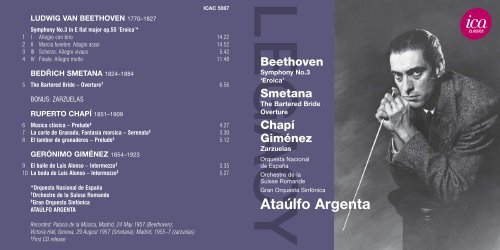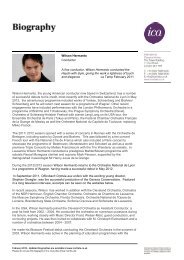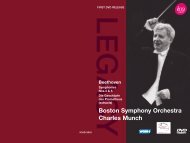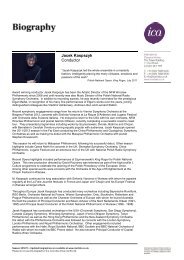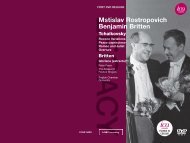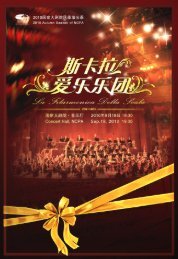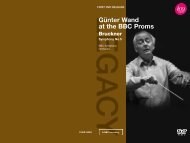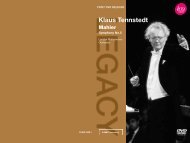to download - International Classical Artists
to download - International Classical Artists
to download - International Classical Artists
You also want an ePaper? Increase the reach of your titles
YUMPU automatically turns print PDFs into web optimized ePapers that Google loves.
ICAC 5087<br />
LUDWIG VAN BEETHOVEN 1770–1827<br />
Symphony No.3 in E flat major op.55 ‘Eroica’*<br />
1 I Allegro con brio 14.22<br />
2 II Marcia funebre: Adagio assai 14.52<br />
3 III Scherzo: Allegro vivace 5.42<br />
4 IV Finale: Allegro mol<strong>to</strong> 11.48<br />
BEDŘICH SMETANA 1824–1884<br />
5 The Bartered Bride – Overture † 6.56<br />
BONUS: ZARZUELAS<br />
RUPERTO CHAPÍ 1851–1909<br />
6 Música clásica – Prelude ‡ 4.27<br />
7 La corte de Granada, Fantasía morsica – Serenata ‡ 3.30<br />
8 El tambor de granaderos – Prelude ‡ 5.12<br />
GERÓNIMO GIMÉNEZ 1854–1923<br />
9 El baile de Luis Alonso – Intermezzo ‡ 3.35<br />
10 La boda de Luis Alonso – Intermezzo ‡ 5.27<br />
*Orquesta Nacional de España<br />
† Orchestre de la Suisse Romande<br />
‡ Gran Orquesta Sinfónica<br />
ATAÚLFO ARGENTA<br />
Beethoven<br />
Symphony No.3<br />
‘Eroica’<br />
Smetana<br />
The Bartered Bride<br />
Overture<br />
Chapí<br />
Giménez<br />
Zarzuelas<br />
Orquesta Nacional<br />
de España<br />
Orchestre de la<br />
Suisse Romande<br />
Gran Orquesta Sinfónica<br />
Ataúlfo Argenta<br />
Recorded: Palacia de la Música, Madrid, 24 May 1957 (Beethoven);<br />
Vic<strong>to</strong>ria Hall, Geneva, 29 August 1957 (Smetana); Madrid, 1955–7 (zarzuelas)<br />
‡ First CD release
ARGENTA CONDUCTS BEETHOVEN,<br />
SMETANA AND ZARZUELAS<br />
Mozart. Schubert. Gershwin. Ferrier. Lipatti. Cantelli. Those<br />
are but a handful of lionised musicians whose lives were<br />
cut short by illness or disaster, thus depriving the world of<br />
accomplishments that can hardly be imagined. Another artist<br />
many believe qualifies for this firmament is Ataúlfo Argenta,<br />
dubbed ‘Spain’s No.1 conduc<strong>to</strong>r’ by Time magazine in 1954.<br />
Argenta came <strong>to</strong> international renown through acclaimed<br />
Decca recordings (made from 1953 <strong>to</strong> 1957) and EMI<br />
recordings of beloved classical works and zarzuelas with<br />
English, French, Spanish and Swiss orchestras. His American<br />
debut was on the horizon, and he was scheduled <strong>to</strong> record<br />
the four Brahms symphonies with the Vienna Philharmonic<br />
for Decca in spring 1958. But on a cold night in January of<br />
that year, while waiting for the studio in his Madrid home<br />
<strong>to</strong> warm up, the forty-four-year-old Argenta switched on<br />
his car mo<strong>to</strong>r and heater without opening the garage door.<br />
A student who was with him ‘was found unconscious and<br />
Argenta died of carbon monoxide poisoning,’ wrote Alan<br />
Sanders in a biography for the box set of the conduc<strong>to</strong>r’s<br />
complete Decca discography. ‘On the day of his funeral<br />
crowds lined the streets through which the cortège passed,<br />
and his death was mourned [throughout Spain].’<br />
The dynamism and insight Argenta shared with<br />
musicians and audiences can be heard on these<br />
recordings, but they aren’t the only evidence of his<br />
charisma as interpreter of an array of music. From<br />
performances taped in concert, one hears a master<br />
communica<strong>to</strong>r who takes nothing for granted and delves<br />
deeply in<strong>to</strong> the messages the composer set down. Among<br />
those performances are the selections on the present disc,<br />
which find Argenta as vibrant in well-known works by<br />
Beethoven and Smetana as he is in orchestral excerpts<br />
2<br />
from zarzuelas, those popular Spanish theatrical blends of<br />
operatic and folk elements.<br />
Born in the northern region of Cantabria in 1913, Argenta<br />
studied voice, violin and piano, advancing so quickly on the<br />
last instrument that he thought a career as a concert pianist<br />
might be possible. After his debut as a conduc<strong>to</strong>r in 1934, he<br />
juggled these two facets of music-making until conducting<br />
dominated his professional life. Concerts with the Spanish<br />
National Orchestra – and recordings, including the first<br />
commercial release of Joaquín Rodrigo’s Concier<strong>to</strong> de<br />
Aranjuez, with guitarist Regino Sáinz de la Maza, the work’s<br />
dedicatee, as soloist – led <strong>to</strong> appearances with ensembles<br />
outside of Spain. Argenta appeared as guest with the London<br />
Symphony, London Philharmonic, Paris Conserva<strong>to</strong>ire<br />
Orchestra and L’Orchestre de la Suisse Romande, whose<br />
music direc<strong>to</strong>r, Ernest Ansermet, so admired him that he<br />
began grooming him <strong>to</strong> be his successor.<br />
In addition <strong>to</strong> the Decca recordings, a prime selection<br />
of Argenta performances are preserved on a collection in<br />
EMI’s ‘Great Conduc<strong>to</strong>rs of the 20th Century’ series, which<br />
includes a fervent Liszt (A Faust Symphony), ravishing<br />
Ravel (Alborada del gracioso), broad and noble Schubert<br />
(Ninth Symphony) and sizzling Falla (El amor brujo). These<br />
recordings were made with the Paris Conserva<strong>to</strong>ire<br />
Orchestra and the so-called Orchestre des Cen<strong>to</strong> Soli (a<br />
melding of Parisian musicians), which confirms the high<br />
esteem in which Argenta was held in the French capital.<br />
The Geneva-based Suisse Romande is one of the<br />
orchestras with which Argenta collaborates on the present<br />
recording in a rollicking account of the overture <strong>to</strong><br />
Smetana’s The Bartered Bride from August 1957, five<br />
months before his death. After the explosive opening,<br />
Argenta keeps a tight reign on the chattering string lines,<br />
maintaining utmost transparency of texture and articulation.<br />
The activity is propulsive, with a tremendous crescendo<br />
leading in<strong>to</strong> the jubilant main theme, which is lovingly<br />
phrased. Argenta makes sure fugal entrances hit the<br />
bull’s eye, even as he stresses the vivacious folksiness<br />
with which Smetana introduces his opera’s exuberant<br />
personality. The performance takes a slight breath near<br />
the end before dashing <strong>to</strong> the finish line.<br />
Like Smetana, Beethoven doesn’t figure on Argenta’s<br />
recorded reper<strong>to</strong>ire list, which makes the performance<br />
of the ‘Eroica’ Symphony here with the Spanish National<br />
Orchestra from May 1957 such an important document.<br />
While it’s apparent that this orchestra is not on the level of<br />
other ensembles he led, especially the London Symphony<br />
(which Sanders considers the first ‘truly virtuosic body’<br />
he conducted), the performance presents Argenta as a<br />
commanding and disciplined Beethoven interpreter. He<br />
shapes a propulsive first movement, without shortchanging<br />
elasticity, and achieves exceptional clarity. The second<br />
movement builds <strong>to</strong> majestic climaxes, the Scherzo is lithe<br />
and swaggering (thanks partly <strong>to</strong> vivacious horns) and the<br />
finale possesses exceptional kinetic intensity.<br />
The zarzuela excerpts, performed with Madrid’s Gran<br />
Orquesta Sinfónica from 1955 <strong>to</strong> 1957, reveal Argenta’s<br />
special <strong>to</strong>uch in music of lighter character. A quote from<br />
the second movement of Beethoven’s ‘Pas<strong>to</strong>ral’ Symphony<br />
and bits of Mendelssohn make endearing appearances in<br />
the first zarzuela selection, the Prelude <strong>to</strong> Ruper<strong>to</strong> Chapí’s<br />
Música clásica. Argenta also elicits bountiful charm,<br />
humour and Spanish flair from the remaining pieces by<br />
Chapí and Gerónimo Giménez. Hearing the conduc<strong>to</strong>r<br />
apply such authority <strong>to</strong> these delectable morsels, it’s no<br />
surprise that he recorded fifty complete zarzuelas. But we<br />
can only wonder what more this ‘great conduc<strong>to</strong>r of the<br />
20th century’ would have contributed if he hadn’t perished<br />
early in such a bizarre accident.<br />
Donald Rosenberg<br />
3<br />
ARGENTA DIRIGE BEETHOVEN,<br />
SMETANA ET DES ZARZUELAS<br />
Mozart. Schubert. Gershwin. Ferrier. Lipati. Cantelli. Ce ne<br />
sont là que quelques-uns parmi les nombreux musiciens<br />
adulés dont la vie fut coupée net par la maladie ou une<br />
catastrophe, privant ainsi le monde de merveilles que l’on<br />
a bien de la peine à imaginer. Un autre artiste que<br />
beaucoup considèrent comme digne de figurer à ce<br />
firmament est Ataúlfo Argenta, surnommé “le meilleur chef<br />
d’orchestre de l’Espagne” par le Time Magazine en 1954.<br />
Argenta acquit une renommée internationale grâce à des<br />
enregistrements Decca (réalisés de 1953 à 1957) et de<br />
classiques favoris et de zarzuelas EMI avec des orchestres<br />
anglais, français, espagnols et suisses. Il allait faire ses<br />
débuts en Amérique et devait enregistrer les quatre<br />
symphonies de Brahms avec le Philharmonique de Vienne<br />
pour Decca au printemps 1958 lorsqu’une froide nuit de<br />
janvier de cette année-là, à Madrid, en attendant que son<br />
studio se réchauffe, il alluma le moteur et le chauffage de<br />
sa voiture sans ouvrir la porte du garage. Un étudiant qui<br />
se trouvait avec lui fut “retrouvé inconscient, et Argenta<br />
[qui n’avait que quarante-quatre ans] décéda d’un<br />
empoisonnement au monoxyde de carbone”, écrivit Alan<br />
Sanders dans une biographie destinée au coffret de la<br />
discographie complète du chef d’orchestre chez Decca.<br />
“Le jour de ses funérailles, la foule se pressait le long des<br />
rues par lesquelles passait le cortège funèbre, et sa mort<br />
fut pleurée [à travers <strong>to</strong>ut l’Espagne].”<br />
Le dynamisme et l’intelligence d’Argenta, qui<br />
rejaillissaient sur les musiciens et le public,<br />
transparaissent dans ces enregistrements, mais ne<br />
sont pas les seules manifestations du charisme de cet<br />
interprète d’œuvres musicales fort diverses. Dans ses<br />
concerts enregistrés en public, on entend à l’ouvrage un
maître de la communication qui ne prend rien pour acquis<br />
et explore à fond le message du compositeur. Parmi ces<br />
interprétations, celles réunies ici montrent un Argenta<br />
aussi dynamique dans les chefs-d’œuvre bien connus de<br />
Beethoven et de Smetana que dans les extraits orchestraux<br />
de zarzuelas, ces mélanges populaires espagnols<br />
d’éléments folkloriques et d’opéra.<br />
Né en 1913 dans le nord de l’Espagne, en Cantabrie,<br />
Argenta étudia le chant, le violon et le piano, faisant des<br />
progrès si fulgurants au clavier qu’il envisagea une carrière<br />
de pianiste de concert. Après ses débuts au pupitre de<br />
chef d’orchestre, en 1934, il jongla avec ces deux facettes<br />
de son talent, jusqu’à ce que la direction d’orchestre<br />
finisse par dominer sa vie professionnelle. Des concerts<br />
avec l’Orchestre national Espagnol, ainsi que des<br />
enregistrements, dont le premier enregistrement du<br />
Concier<strong>to</strong> de Aranjuez de Joaquín Rodrigo, avec en soliste<br />
le guitariste Regino Sáinz de la Maza, le dédicataire de<br />
l’œuvre, l’amenèrent à se produire en-dehors de l’Espagne<br />
à la tête de divers ensembles. Il fut ainsi invité par le<br />
London Symphony, le London Philharmonic, l’Orchestre du<br />
Conserva<strong>to</strong>ire de Paris et l’Orchestre de la Suisse Romande,<br />
dont le directeur musical, Ernest Anseremet, l’admirait<br />
tellement qu’il le prépara à prendre sa succession.<br />
En plus des enregistrements Decca, une excellente<br />
sélection d’interprétations d’Argenta est parue chez EMI<br />
dans la série Great Conduc<strong>to</strong>rs of the 20th Century, qui<br />
comprend un Liszt passionné (Faust-Symphonie), un Ravel<br />
enchanteur (Alborada del gracioso), un Schubert large et<br />
noble (Neuvième Symphonie) et un Falla <strong>to</strong>rride (El amor<br />
brujo). Ces enregistrements furent réalisés avec l’Orchestre<br />
du Conserva<strong>to</strong>ire de Paris et l’Orchestre des Cen<strong>to</strong> Soli (un<br />
ensemble de musiciens parisiens d’horizons divers), ce<br />
qui confirme la haute estime dont jouissait Argenta dans la<br />
capitale française.<br />
L’Orchestre de la Suisse Romande basé à Genève<br />
est la formation que dirige Argenta dans l’interprétation<br />
joyeuse de l’ouverture de La Fiancée vendue de Smetana,<br />
captée en août 1957, cinq mois avant la mort du chef<br />
d’orchestre. Après un début explosif, Argenta tient<br />
fermement les lignes mélodiques bavardes des cordes,<br />
maintenant une parfaite transparence dans la texture et<br />
l’articulation. Il propulse l’action vers l’avant avec un<br />
formidable crescendo menant au thème principal radieux,<br />
phrasé avec amour. Argenta s’assure que les entrées<br />
fuguées sont parfaitement exactes, même lorsqu’il met en<br />
évidence l’esprit populaire et enjoué par lequel Smetana<br />
ouvre son opéra exubérant. Peu avant la fin, il reprend<br />
haleine, avant de se précipiter vers les notes finales.<br />
Tout comme Smetana, Beethoven ne figure pas sur<br />
la liste des œuvres enregistrées par Argenta, ce qui<br />
donne une importance <strong>to</strong>ute particulière à son Eroica<br />
avec l’Orchestre national Espagnol captée en mai 1957.<br />
S’il apparaît clairement que cet orchestre n’est pas au<br />
même niveau que d’autres ensembles qu’il avait dirigés,<br />
principalement le London Symphony (que Sanders<br />
considère comme le premier “ensemble réellement<br />
virtuose” qu’Argenta ait dirigé), l’enregistrement nous<br />
montre un interprète de Beethoven à la fois discipliné et<br />
imposant. Argenta façonne un premier mouvement vif, sans<br />
négliger la souplesse, et obtient une clarté exceptionnelle.<br />
Le deuxième mouvement s’élève à des sommets<br />
majestueux, le Scherzo est agile et fanfaron (en partie<br />
grâce aux cors pleins de vivacité) et le Finale développe<br />
une intensité cinétique exceptionnelle.<br />
Les extraits de zarzuelas, interprétés avec le Gran<br />
Orquesta Sinfónica de Madrid de 1955 à 1957, révèlent<br />
la <strong>to</strong>uche particulière qu’Argenta apporte à la musique<br />
plus légère. Une citation du deuxième mouvement de la<br />
Symphonie “Pas<strong>to</strong>rale” de Beethoven et des emprunts à<br />
Mendelssohn font des apparitions <strong>to</strong>uchantes dans le<br />
premier extrait de zarzuela, le Prélude de la Música<br />
clásica de Ruper<strong>to</strong> Chapí. Argenta met également en<br />
valeur le charme généreux, l’humour et l’esprit espagnol<br />
des autres pièces de Chapí et de Gerónimo Giménez.<br />
Vu la maestria avec laquelle il traite ces petits bijoux, on<br />
n’est guère surpris qu’il ait enregistré cinquante zarzuelas<br />
intégralement. Et l’on ne peut que se demander ce que ce<br />
“grand chef d’orchestre du XX e siècle” aurait encore<br />
apporté au monde s’il n’avait péri prématurément dans<br />
un accident aussi absurde.<br />
Donald Rosenberg<br />
Traduction : Sophie Liwszyc<br />
4 5<br />
ARGENTA DIRIGIERT BEETHOVEN,<br />
SMETANA UND ZARZUELAS<br />
Mozart. Schubert. Gershwin. Ferrier. Lipatti. Cantelli. Dies<br />
sind nur eine Handvoll von vergötterten Musikern, deren<br />
Leben durch Krankheit oder Katastrophe vorzeitig<br />
abgeschnitten wurde, was der Welt kaum vorstellbare<br />
Leistungen vorenthalten hatte. Ein weiterer Künstler, von<br />
dem viele glauben, dass auch er in dieses Firmament<br />
gehört, ist Ataúlfo Argenta, den die Zeitschrift Time<br />
1954 den “Ersten Dirigenten Spaniens” nannte. Argenta<br />
errang sich durch hochgepriesene Aufnahmen für Decca<br />
(1953–1957) und EMI-Einspielungen von beliebten<br />
klassischen Werken und Zarzuelas mit englischen,<br />
französischen, spanischen und Schweizer Orchestern<br />
internationales Ansehen. Sein amerikanisches Debüt stand<br />
kurz bevor, und im Frühjahr 1958 sollte er mit den Wiener<br />
Philharmonikern die vier Brahms-Sinfonien für Decca<br />
einspielen, als der 44-jährige Dirigent in einer kalten Nacht<br />
in diesem Jahr in seinem Au<strong>to</strong> darauf wartete, dass sich das<br />
Studio in seiner Wohnung in Madrid aufwärmte, und den<br />
Mo<strong>to</strong>r für die Heizung anließ, ohne das Garagen<strong>to</strong>r zu<br />
öffnen. Ein Student, der mit ihm im Au<strong>to</strong> war, “wurde<br />
bewusstlos gefunden, und Argenta starb an<br />
Kohlenmonoxidvergiftung”, schrieb Alan Sanders in seiner<br />
Biografie für ein Boxset der gesamten Decca-Diskografie<br />
des Dirigenten. “Am Tag seines Begräbnisses säumten<br />
große Scharen die Straßen, durch die der Leichenzug führte,<br />
und sein Tod wurde [in ganz Spanien] betrauert.”<br />
Die Dynamik und Einsicht, die Argenta mit Musikern<br />
und Publikum teilte, lässt sich auf diesen Einspielungen<br />
hören, aber sie sind nicht die einzigen Zeugnisse für sein<br />
Charisma als Interpret einer großen Vielfalt von Musik. In<br />
Konzertmitschnitten hört man einen meisterlichen<br />
Kommunika<strong>to</strong>r, der nichts für selbstverständlich hält und
sich in die Botschaften vertieft, die der Komponist<br />
vermittelt. Die Auswahl auf der vorliegenden CD<br />
stammt aus diesen Aufführungen, in denen Argenta in<br />
wohlbekannten Werken von Beethoven und Smetana<br />
genauso dynamisch ist wie in Orchesterauszügen aus<br />
Zarzuelas, der populären spanischen Mischung von<br />
Oper und Volksmusik.<br />
Argenta wurde 1913 im nördlichen Kantabrien geboren<br />
und studierte Gesang, Violine und Klavier. Er machte auf<br />
dem Klavier so schnelle Fortschritte, dass er eine Karriere<br />
als Konzertpianist für möglich hielt. Nach seinem Debüt als<br />
Dirigent 1934 jonglierte er mit diesen beiden Disziplinen,<br />
bis das Dirigieren schließlich die professionelle Oberhand<br />
gewann. Konzerte mit dem Spanischen Nationalorchester –<br />
und Aufnahmen einschließlich der ersten kommerziellen<br />
Aufnahme von Joaquín Rodrigos Concier<strong>to</strong> de Aranjuez, mit<br />
dem Gitarristen und Widmungsträger des Werks Regino<br />
Sáinz de la Maza als Solisten – führte zu Auftritten mit<br />
Ensembles außerhalb Spaniens. Argenta erschien als Gast<br />
mit dem London Symphony, London Philharmonic, Pariser<br />
Conserva<strong>to</strong>ire-Orchester und L’Orchestre de la Suisse<br />
Romande, dessen Musikdirek<strong>to</strong>r Ernest Ansermet ihn so<br />
sehr bewunderte, dass er begann, ihn als seinen<br />
Nachfolger zu präparieren.<br />
Zusätzlich zu den Decca-Einspielungen ist auch<br />
eine erstklassisge Auswahl von Argenta-Aufführungen<br />
in einer Sammlung der EMI-Serie “Große Dirigenten<br />
des 20. Jahrhunderts” erhalten, die einen feurigen Liszt<br />
(Eine Faust-Sinfonie), mitreißenden Ravel (Alborada<br />
del gracioso), ausladend-noblen Schubert (Neunte<br />
Sinfonie) und glühend heißen Falla (El amor brujo)<br />
enthält. Diese Aufnahmen entstanden mit dem Pariser<br />
Conserva<strong>to</strong>ire-Orchester und dem sogenannten Orchestre<br />
des Cen<strong>to</strong> Soli (einer Verschmelzung Pariser Musiker)<br />
und unterstreichen wie hoch Argenta in der französischen<br />
6<br />
Hauptstadt geschätzt wurde.<br />
In der im August 1957, nur fünf Monate vor seinem<br />
Tode eingespielten augelassenen Interpretation der<br />
Ouvertüre zu Smetanas Verkaufter Braut arbeitete Argenta<br />
mit dem in Genf ansässigen Orchestre de la Suisse<br />
Romande. Nach dem explosiven Beginn hält Argenta<br />
die geschwätzigen Streicherlinien fest im Zügel, um<br />
äußerste Transparenz des Satzes und der Artikulation<br />
aufrechtzuerhalten. Er treibt die Handlung stets voran und<br />
ein überwältigendes Crescendo führt in das liebevoll<br />
phrasierte Hauptthema. Argenta stellt sicher, dass<br />
Fugeneinsätze immer ins Schwarze treffen und unterstreicht<br />
gleichzeitig die lebhafte Volkstümlichkeit, mit der Smetana<br />
die überschwängliche Persönlichkeit seiner Oper einführt.<br />
Vor dem Endspurt hält die Aufführung für eine kurze<br />
Verschnaufpause ein.<br />
Wie Smetana fehlt auch Beethoven in Argentas<br />
Aufnahmeliste, was die hier vorliegende Aufführung der<br />
“Eroica” mit dem Spanischen Nationalorchester vom Mai<br />
1957 zu einem so bedeutenden Dokument macht. Obwohl<br />
dieses Orchester offensichtlich nicht ganz auf dem<br />
gleichen Niveau steht wie die anderen Ensembles die er<br />
leitete – besonders das London Symphony Orchestra (das<br />
Sanders als den ersten “wahrhaft virtuosen Musikerkorpus”<br />
bezeichnete, den er leitete) – zeigt die Aufführung Argenta<br />
als kommandierenden und disziplinierten<br />
Beethoven-Interpreten. Er gestaltet einen<br />
vorwärtstreibenden ersten Satz, der trotzdem elastisch<br />
bleibt, und erreicht eine außerordentliche Klarheit. Der<br />
zweite Satz steigert sich in majestätische Höhepunkte, das<br />
Scherzo ist geschmeidig und aufschneiderisch (zum Teil<br />
dank lebhafter Hörner), und das Finale besitzt<br />
außerordentliche kinetische Intensität.<br />
Die Zarzuela-Ausschnitte, die zwischen 1955 und 1957<br />
mit dem Madrider Gran Orquesta Sinfónica aufgeführt<br />
wurden, enthüllen Argentas besonderen Touch in Musik<br />
der leichteren Musik. In der ersten Zarzuela-Auswahl, dem<br />
Vorspiel zu Ruper<strong>to</strong> Chapís Música clásica tauchen ein<br />
Zitat aus dem zweiten Satz von Beethovens “Pas<strong>to</strong>rale”<br />
und und hier und da ein bisschen Mendelssohn auf.<br />
Argenta holt auch aus den übrigen Stücken von Chapí<br />
und Gerónimo Giménez viel Humor und spanisches<br />
Flair heraus. Wenn man hört, wieviel Au<strong>to</strong>rität er diesen<br />
entzückenden Musikhäppchen verleiht, überrascht es nicht,<br />
dass er 50 vollständige Zarzuelas aufnahm. Wir können<br />
aber nur spekulieren, wieviel mehr dieser “große Dirigent<br />
des 20. Jahrhunderts” hätte beitragen können, wenn er<br />
nicht in so frühem Alter in einem solch bizarren<br />
Missgeschick umgekommen wäre.<br />
Donald Rosenberg<br />
Übersetzung: Renate Wendel<br />
For a free promotional CD sampler including<br />
highlights from the ICA Classics CD catalogue,<br />
please email info@icaclassics.com.<br />
7<br />
For ICA Classics<br />
Executive Producer/Head of Audio: John Pattrick<br />
Music Rights Executive: Aurélie Baujean<br />
Head of DVD: Louise Waller-Smith<br />
Executive Consultant: Stephen Wright<br />
Remastering: Peter Reynolds (Reynolds Mastering)<br />
Introduc<strong>to</strong>ry note & translations<br />
2012 <strong>International</strong> <strong>Classical</strong> <strong>Artists</strong> Ltd<br />
Booklet editing: WLP Ltd<br />
Art direction: Georgina Curtis for WLP Ltd<br />
2012 <strong>International</strong> <strong>Classical</strong> <strong>Artists</strong> Ltd<br />
2012 <strong>International</strong> <strong>Classical</strong> <strong>Artists</strong> Ltd<br />
Technical Information<br />
TC M6000 Mastering Processor<br />
Lexicon 300 Reverb<br />
JBL, Genelec & PMC Moni<strong>to</strong>r Speakers<br />
Todd Electronics cus<strong>to</strong>m built Pre amp/Switcher,<br />
Digital Power Amp and Metering Unit<br />
STAX Electrostatic headphones<br />
Sonic soundBlade HD and Bias Peak Pro 7 Non Linear Editing Systems<br />
Izo<strong>to</strong>pe RX II Advanced and Algorithmics Renova<strong>to</strong>r software<br />
Mono ADD<br />
Original broadcasts from Radio Nacional de España (Beethoven)<br />
& Radio Suisse Romande (Smetana)<br />
WARNING:<br />
All rights reserved. Unauthorised copying, reproduction, hiring,<br />
lending, public performance and broadcasting prohibited.<br />
Licences for public performance or broadcasting may be obtained<br />
from Phonographic Performance Ltd., 1 Upper James Street,<br />
London W1F 9DE. In the United States of America unauthorised<br />
reproduction of this recording is prohibited by Federal law and<br />
subject <strong>to</strong> criminal prosecution.<br />
Made in Austria
Also available on CD and digital <strong>download</strong>:<br />
ICAC 5000<br />
Beethoven: Piano Concer<strong>to</strong>s Nos.1 & 3<br />
New Philharmonia Orchestra · Sir Adrian Boult<br />
Emil Gilels<br />
ICAC 5001<br />
Mahler: Symphony No.2 ‘Resurrection’<br />
Stefania Woy<strong>to</strong>wicz · Anny Delorie<br />
Kölner Rundfunkchor u. Rundfunk-Sinfonie-Orchester<br />
William Steinberg<br />
ICAC 5006<br />
Verdi: La traviata<br />
Maria Callas · Cesare Valletti · Mario Zanasi<br />
The Covent Garden Opera Chorus & Orchestra<br />
Nicola Rescigno · Supersonic Award (Pizzica<strong>to</strong> Magazine)<br />
ICAC 5007<br />
Tchaikovsky: Symphony No.1 ‘Winter Dreams’<br />
Stravinsky: The Firebird Suite (1945 version)<br />
BBC Symphony Orchestra · Philharmonia Orchestra<br />
Evgeny Svetlanov<br />
ICAC 5003<br />
Brahms: Piano Concer<strong>to</strong> No.2<br />
Chopin · Falla<br />
Kölner Rundfunk-Sinfonie-Orchester<br />
Chris<strong>to</strong>ph von Dohnányi · Arthur Rubinstein<br />
Gramophone Edi<strong>to</strong>rs’ Choice<br />
ICAC 5004<br />
Haydn: Piano Sonata No.62<br />
Weber: Piano Sonata No.3<br />
Schumann · Chopin · Debussy<br />
Svia<strong>to</strong>slav Richter<br />
Diapason d’or<br />
ICAC 5008<br />
Liszt: Rhapsodie espagnole<br />
Hungarian Rhapsody No.2<br />
CPE Bach · Couperin · Scarlatti<br />
Georges Cziffra<br />
ICAC 5019<br />
Brahms: Symphony No.1<br />
Elgar: Enigma Variations<br />
BBC Symphony Orchestra<br />
Sir Adrian Boult<br />
8<br />
9
ICAC 5021<br />
Mahler: Symphony No.3 · Debussy: La Mer<br />
Kölner Rundfunkchor · Kölner Domchor<br />
Kölner Rundfunk-Sinfonie-Orchester · Dimitri Mitropoulos<br />
Toblacher Komponierhäuschen <strong>International</strong><br />
Record Prize 2011<br />
ICAC 5022<br />
Puccini: Tosca<br />
Renata Tebaldi · Ferruccio Tagliavini · Ti<strong>to</strong> Gobbi<br />
The Covent Garden Opera Chorus & Orchestra<br />
Francesco Molinari-Pradelli<br />
ICAC 5035<br />
Tchaikovsky: Symphony No.4 · Mussorgsky: A Night<br />
on the Bare Mountain (‘Sorochinsky Fair’ version)<br />
Prokofiev: ‘The Love for Three Oranges’ Suite<br />
Gennadi Rozhdestvensky<br />
ICAC 5036<br />
Shostakovich: Symphony No.10<br />
Tchaikovsky · Rimsky-Korsakov<br />
USSR State Symphony Orchestra<br />
Evgeny Svetlanov<br />
ICAC 5032<br />
Beethoven: Piano Concer<strong>to</strong> No.4<br />
Tchaikovsky: Piano Concer<strong>to</strong> No.2<br />
Hallé Orchestra · Sir John Barbirolli<br />
London Philharmonic Orchestra · Kirill Kondrashin<br />
Emil Gilels<br />
ICAC 5033<br />
Mahler: Symphony No.3<br />
Waltraud Meier · E<strong>to</strong>n College Boys’ Choir<br />
London Philharmonic Choir & Orchestra<br />
Klaus Tennstedt<br />
Choc de Classica · Diapason d’or<br />
ICAC 5045<br />
Chopin: Piano Concer<strong>to</strong> No.1<br />
Beethoven: Piano Concer<strong>to</strong> No.4<br />
Ot<strong>to</strong> Klemperer · Chris<strong>to</strong>ph von Dohnányi<br />
Kölner Rundfunk-Sinfonie-Orchester · Claudio Arrau<br />
Supersonic Award (Pizzica<strong>to</strong> Magazine)<br />
ICAC 5046<br />
Rossini: Il barbiere di Siviglia<br />
Rolando Panerai · Teresa Berganza · Luigi Alva<br />
The Covent Garden Opera Chorus & Orchestra<br />
Carlo Maria Giulini<br />
10<br />
11
ICAC 5047<br />
Mendelssohn: A Midsummer Night’s Dream<br />
Beethoven: Symphony No.8<br />
Kölner Rundfunkchor · Kölner Rundfunk-Sinfonie-Orchester<br />
Ot<strong>to</strong> Klemperer<br />
ICAC 5048<br />
Brahms: Piano Concer<strong>to</strong> No.1<br />
Chopin · Liszt · Schumann · Albéniz<br />
BBC Symphony Orchestra · Rudolf Kempe<br />
Julius Katchen<br />
ICAC 5061<br />
Verdi: Falstaff<br />
Fernando Corena · Anna Maria Rovere · Fernanda Cadoni<br />
Glyndebourne Opera Chorus<br />
Royal Philharmonic Orchestra<br />
Carlo Maria Giulini<br />
ICAC 5063<br />
Brahms: Symphony No.3<br />
Elgar: Symphony No.1<br />
BBC Symphony Orchestra<br />
Sir Adrian Boult<br />
Supersonic Award (Pizzica<strong>to</strong> Magazine)<br />
ICAC 5053<br />
Holst: The Planets<br />
Britten: Variations and Fugue on a Theme of Purcell<br />
BBC Symphony Orchestra<br />
Gennadi Rozhdestvensky<br />
ICAC 5054<br />
Beethoven: Missa solemnis<br />
Kölner Rundfunkchor<br />
Kölner Rundfunk-Sinfonie-Orchester<br />
William Steinberg<br />
ICAC 5068<br />
Verdi: Requiem · Rossini: Overtures<br />
Moscow Philharmonic Orchestra<br />
Orchestre National de l’ORTF<br />
Igor Markevitch<br />
ICAC 5069<br />
Rachmaninov: The Bells<br />
Prokofiev: Alexander Nevsky<br />
BBC Symphony Chorus and Orchestra<br />
Philharmonia Chorus and Orchestra<br />
Evgeny Svetlanov<br />
12<br />
13
ICAC 5077<br />
Brahms: Piano Concer<strong>to</strong> No.2<br />
Debussy · Prokofiev<br />
Kölner Rundfunk-Sinfonie-Orchester<br />
Mario Rossi<br />
Emil Gilels<br />
ICAC 5078<br />
Rachmaninov: Symphony No.2<br />
Bernstein: Candide – Overture<br />
Philharmonia Orchestra<br />
London Symphony Orchestra<br />
Evgeny Svetlanov<br />
ICAC 5081<br />
Schumann: Symphony No.4<br />
Debussy: Le Martyre de Saint Sébastien – Suite<br />
Philharmonia Orchestra<br />
Guido Cantelli<br />
ICAC 5084<br />
Beethoven: Piano Sonata No.3<br />
Bagatelles op.126 Nos. 1, 4 & 6<br />
Piano Sonata No.29 ‘Hammerklavier’<br />
Svia<strong>to</strong>slav Richter<br />
ICAC 5079<br />
Grieg · Liszt: Piano Concer<strong>to</strong>s<br />
Lully · Scarlatti<br />
Orchestre National de l’ORTF<br />
Georges Tzipine · André Cluytens<br />
Georges Cziffra<br />
ICAC 5080<br />
Mahler: Das klagende Lied<br />
Janáček: The Fiddler’s Child<br />
Teresa Cahill · Janet Baker · Robert Tear · Gwynne Howell<br />
BBC Symphony Chorus and Orchestra<br />
Gennadi Rozhdestvensky<br />
ICAC 5085<br />
Chopin: Piano Concer<strong>to</strong>s Nos. 1 & 2<br />
BBC Scottish Symphony Orchestra · Chris<strong>to</strong>pher Adey<br />
BBC Symphony Orchestra · Richard Hickox<br />
Shura Cherkassky<br />
ICAC 5086<br />
Beethoven: Piano Concer<strong>to</strong>s Nos. 2 & 4<br />
Sinfonia Varsovia<br />
Jacek Kaspszyk<br />
Ingrid Jacoby<br />
14<br />
15


